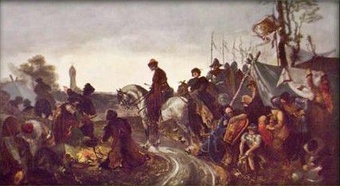
The Hussite reform
It is the name of a revolutionary movement, which promoted the extensive reorganization of the Church and was based on the teachings of Master Jan Hus. Its influence reached far-off corners of Europe, mainly in Central Europe.
By the late 14th century, various crisis situations gradually fused to create an ideal breeding ground for revolution. Due to the excessive schooling of intellectuals (following the founding of the Charles University), there was a proportional decrease in their employment. Artificial interventions such as the Edict of Kutna Hora only served to fuel the situation. Another important crisis was the Black Death epidemic, the plague. It affected the Czech lands only marginally but was seen as a great menace and had an impact on agricultural production. The consequence was unrest and inquietude among all social classes.
The detonator of the revolution was the great power of the Church, its bloated wealth and the profiteering within its structure, which was seen as a great provocation, in particular in these difficult times. The theological-philosophical quarrel between Wycliff’s reformatory dogma and the standard Catholic doctrine soon led to the escalation of the conflict between the charismatic Prague preacher Jan Hus and the Pope’s faithful supporters. Hus made the corruption of the Church his central theme and promoted the return to simplicity and to the origins. He considered Christ to be at the head of the Church, rather than the Pope in Rome. He criticized the trafficking in indulgencies (absolutions) and he promoted Communion under both kinds. For the Church, it was an unquestionable proof of heresy, but Hus benefited for a long time from the support of the king. The latter eventually abandoned him and Hus was burnt at the stake for his ideas during the Council of Constance.
But the reaction in the Czech lands was absolutely not what had been expected by the high officials of the Church. Hus was made a martyr and his ideas, which until then were primarily spread in towns, found a strong support among the common people, and in a very radical form at that. The actual beginning of the Hussite revolution came with the Defenestration of the Prague counselors faithful to the king, in the New Town Hall, by a crowd of Hussites led by Jan Zelivsky. It also caused the death of King Wenceslas IV.
When his brother Sigismund was rejected as his successor and started preparing a crusade against the Hussites, the Hussite towns became highly radical, which resulted in the creation of a new faction,
the Taborites. They were joined by numerous marauders, mercenaries and other such people, who together formed a powerful and unprecedented combat force under the iron leadership of Jan Zizka. In 1420 they managed to defeat the allied troops of the crusaders on Vitkov and later on Vysehrad. After that and during 4 years, Zizka became the toughest leader of the Hussite radicals. In 1421 he crushed the second crusade and because of his radicalism he had to face pressure from moderate Hussites and from the Catholic gentry. But Zizka defeated them in the battle of Malesov and thus strengthened his position. His death that same year came as a great relief for his opponents.
After his death, each faction fought for power and joined forces only in case of a threat coming from outside. In 1426, Procopius the Shaven took command of the Hussite movement and managed to unite all the factions under a common goal. The defeat of the third crusade in 1426 in Usti nad Labem led to the culmination of power of the field troops. They started undertaking so-called Beautiful Rides, expeditions abroad where they spread the ideas of the Hussite reform, while at the same time relieving the Czech lands, suffering from the war. After the defeat of the fourth crusade in 1427 and the fifth in 1431, the Hussites were invited to the negotiating table in Basel, because the Church and the European rulers had come to the conclusion that they wouldn’t be able to overthrow the Hussites from outside with the use of military. The negotiations in Basel were difficult and lasted until 1433, with a radical division between the moderate Utraquists, primarily comprising town people, and the radical Hussite field soldiers. They even had opposite expectations regarding the outcome of the Basel Compact.
The conflict culminated with the fratricide battle of Lipany in 1434, which ended with the defeat of the Hussite radicals and the death of Procopius the Shaven. The troops stopped controlling the country, thus opening the possibility for a more moderate approach. In 1436, Sigismund was elected king and a symbolic line was drawn behind the Hussite Wars.
The consequences of the Hussite reform were evident. The constant presence of field troops were the cause of an agrarian disaster for the Czech lands for almost one century. Damages wrought on Church property and monuments were astronomical. But the legacy of the Hussite line of thought had an impact on all of Europe and was a precursor for later reformation movements in the 16th century.









